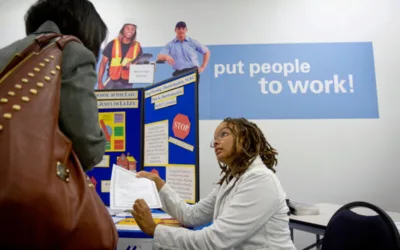
As North Carolina schools reopen, public health leaders will face pressure to require the COVID-19 vaccine. (Image via Shutterstock)
‘Folks are in survival mode right now,’ says Elizabeth City-Pasquotank Public Schools Superintendent Catherine Edmonds.
It’s been about 4 weeks since some school districts opened up for K-5 in person learning. Across the state, some parents are still dealing with the balancing act of work, paying bills, and feeding their families while ensuring their student is getting a quality education.
It has been an unquestionably trying time for school systems too. The results of this fall’s election have been maligned by some North Carolina educators. And with many districts offering an option for in-person learning, concerns about the spread of coronavirus are looming. Indeed, NC reported a single-day high for new coronavirus cases in the state Wednesday.
Cardinal & Pine spoke to Dr. Catherine Edmonds, superintendent of Elizabeth City-Pasquotank Public Schools. Edmonds’ district includes about 5,400 students in northeast NC and is one of the districts that began elementary-grade in-person learning on Oct. 19th. It is a relatively diverse county, with about 58% of the population identifying as white and 36% as Black. We talked about the challenges her district is facing, how the community has stepped in and what North Carolina lawmakers can do to help.
This interview has been edited and condensed for clarity.

C&P: What challenges has your district faced this year?
Dr. Edmonds: The challenge for us has been to see our families who have been suffering. Folks that typically would have jobs are no longer working and seeing that stress in the community, that then spills over into the schools.
There are also inequities in terms of broadband and we have parts of our school district that just cannot get a signal. So you have parents who are trying to work and trying to get students logged on.
And I think the piece that we sometimes forget about are the adults. We assume that all of our educators don’t have struggles, and that they don’t have challenges. And that is not true. I said to the staff, “Our students will not come back to us the same way that they left us in the spring, and neither will you.”
C&P: What challenges have you seen that are disproportionately affecting Black and Latino students?
Dr. Edmonds: We always say we want things to go back to normal, but normal for some students is not good. They may be in homes where there could be violence, some of our students are challenged with the inequities of resources. We’re saying we need you to do schoolwork and folks are in survival mode right now.
We have parents that have to say: “What are the things that I have to prioritize?” And it’s going to be those basic needs, feeding my children, ensuring that we have a home to live in, ensuring that our lights are on. So you’re having those families who already have struggles, and you’re making it more inequitable for them to be able to have access.
C&P: How have schools in your district tackled some of these issues?
Dr. Edmonds: To address some of the broadband inequities, we have what we call “Park and Learns.” Parents can go into the school parking lots, and there are designated areas where they can get on WiFi from their car. We’ve also provided hotspots and we’ve been working so closely with our county commissioners and with the food bank and so many organizations within our school district, they’ve been so generous to us, and very supportive.
We’ve also been intentional about providing resources for the adults in the building. I would have 15-minute drop ins with the principals and the assistant principals. Just to check on them.
Our teachers and our educators are working around the clock, and they are struggling and have challenges. I often think about how we help the adults so they can better help the students.
C&P: How has the district been able to obtain resources not only for remote learning but to make schools safe for in-person instruction?
Dr. Edmonds: So the state did provide school districts across the state some PPE equipment, so we have five face masks per student and for each adult, and they provided some pieces for our school nurses as well like gowns and gloves. We’ve had to provide our own signage to ensure that students socially distance.
We’ve had folks locally provide donations for us to get additional facemasks so that we have enough and we’ve worked with our county commissioners, they’ve given us some funding sources as well to be able to to get additional PPE and of course we’re using the state and federal dollars that we can to access that as well.
C&P: What are some things that the state and local governments can do to help support a little bit more?
Dr. Edmonds: For us in rural northeastern North Carolina, having broadband is a huge piece because a lot hinges on students having accessibility to that. Another piece is that at the state level, we receive state dollars in support of our students that have special-needs students and the state pays for 12.75%. Well, that leaves us with 160 students that we don’t receive state support for. So those dollars have to come out of our local funding or other federal funding to be able to support them. And that’s another piece that I could see that we’ve really needed some support on.
I see some motion in terms of having additional support for school nurses, so we can have a school nurse at every school, school psychologists and social workers. Right now we have two social workers in our school district and we definitely could utilize funding for additional folks and I do see some traction happening around those pieces.

Op-Ed: Studying the Holocaust remains vital to ensuring it never happens again
International Holocaust Day will be observed on January 27, 2024. This day commemorates the liberation of the Auschwitz concentration camp by the...

VIDEO: How Rural Broadband Is Coming to This North Carolina County
More than 1.1 million North Carolinians lack access to high-speed internet, a necessity of the modern economy. In Warren County, help is on the way,...

VIDEO: Sampson County puts Biden’s promise to boost rural infrastructure to the test
Locals in this rural NC county say their water and air is polluted by a PFAS-contaminated landfill, massive hog and poultry farms, and industrial...

VIDEO: Sampson County puts Biden’s promise to boost rural infrastructure to the test
Locals in this rural NC county say their water and air is polluted by a PFAS-contaminated landfill, massive hog and poultry farms, and industrial...

Mold and classes in trailers: Inadequate funding for schools is hurting NC communities
Schools across the state are dealing with dilapidated classrooms and buildings in need of significant repair or a total rebuild due to a lack of...




